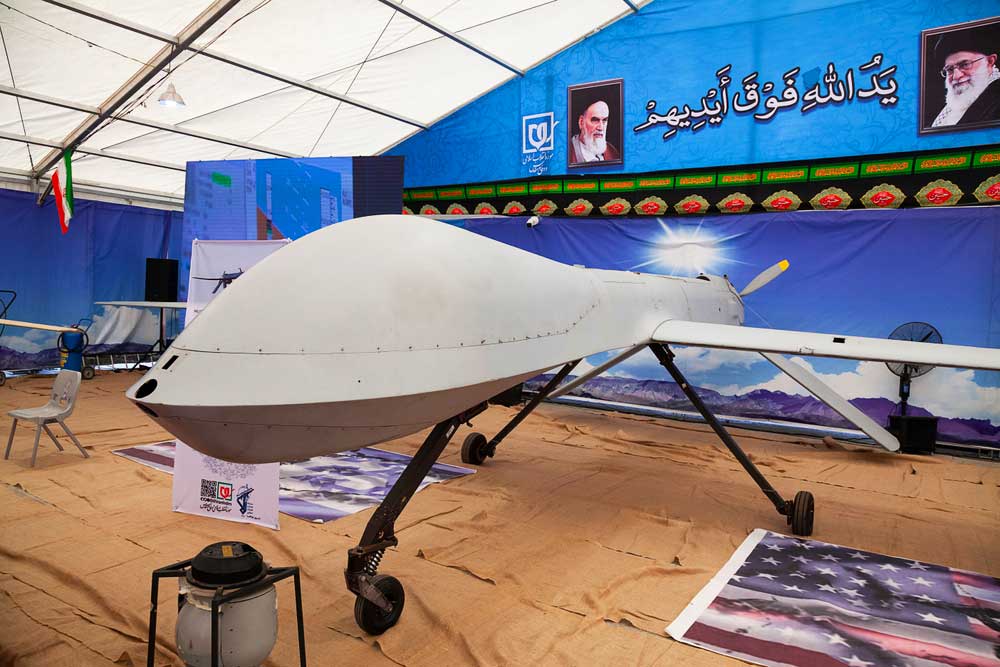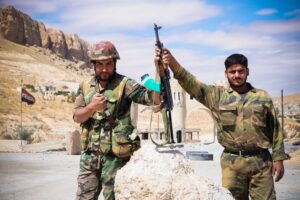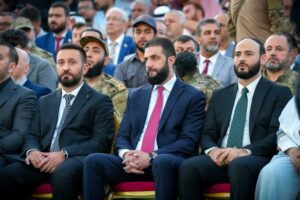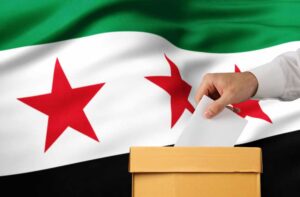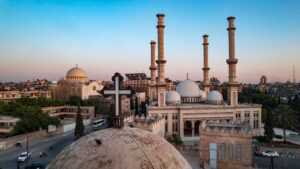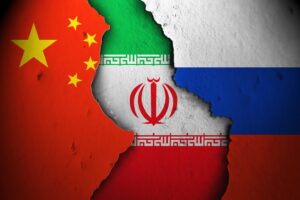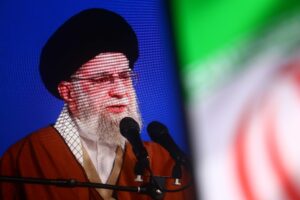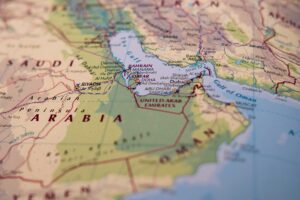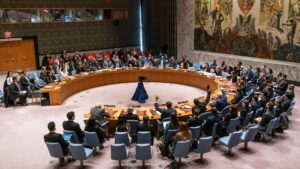Iran’s recent opening of a drone factory in Tajikistan[i] is a significant development for Russia. As Dushanbe’s security and defense patron, Moscow has traditionally been a strict arbiter when it comes to ‘allowing’ other states to use Tajikistani territory for military purposes.[ii] Amidst Russia’s heightened focus on checking its rivals’ moves in Eurasia due to its standoff with the West over Ukraine, Tehran’s Tajikistan drone factory presents a mixed bag for Moscow.
Gatekeeping the Near Abroad
Tajikistan and its fellow Central Asian republics are part of what Russia sees as its Eurasian ‘Near Abroad’ of former Soviet states, which it must guard as its geopolitical turf against non-Russian powers.[iii] Russia’s escalating rivalry with the West from the mid-2000s onwards made it more sensitive to the US and European Union (EU) filling the post-Soviet vacuums in the Near Abroad’s security, diplomatic and economic architecture. As Western overtures to former Soviet states increased, it grew costlier for Russia to pressure them to not oblige. Thus, it started making sense for Moscow to open doors for non-Western powers into Eurasia as alternatives to the West. An example of this was the 2015 Sino-Russian agreement to harmonize China’s Belt Road Initiative (BRI) with the Eurasian Economic Union (EAEU), following the 2014 eruption of Russian-American tensions over Ukraine.[iv] The Moscow-controlled EAEU was otherwise used to keep non-Russian players out of former Soviet markets via protectionist trade policies.
Russia’s acquiescence to Iran’s drone factory in Tajikistan comes in a similar situation: a spike in tensions with the West, this time after Moscow’s February 2022 invasion of Ukraine. However, compared to China, Iran’s ingress into Central Asia may tally less smoothly with Russia’s Eurasia-centered deterrence strategy against the West and introduce variables into Eurasian power dynamics that are beyond Moscow’s control.
Iran, Russia and the West
One of the key assumptions behind Iran’s developing Eurasian strategic posture is that Eurasia is in a period of ‘post-American’ transition.
It is safe to say that Russia need not worry about an expanded Iranian role in Eurasian security affairs creating scope for new US-NATO hard-power strategies in the supercontinent. One of the key assumptions behind Iran’s developing Eurasian strategic posture is that Eurasia is in a period of ‘post-American’ transition. Iran has proactively sought new, lasting relationships with states in the region from where Tehran believes the major trends shaping such ‘post-America’ security and multilateral structures will emerge. For example, Iran’s Tajikistan drone factory gives it strategic proximity to Afghanistan. Tensions between Dushanbe and the Taliban regime have brought northern Afghanistan into the focus of the Collective Security Treaty Organization (CSTO), a Russian-led security bloc comprising former Soviet states close to Moscow.[v] Additionally, Afghanistan featured as a key agenda item in Turkmenistani President Serdar Berdimohammedow’s 15 June visit to Tehran, with his Iranian counterpart Ebrahim Raisi declaring that the two states would sign a 20-year strategic cooperation pact.[vi]
Overall, Iran’s ‘Look East’ doctrine[vii] holds that Russia is one of the major poles of power in Eurasia alongside China. It is therefore highly unlikely that Iran would put its incipient Eurasia strategy in the crosshairs of Russian interests by forming some sort of regional understanding with the US. Catering to U.S. interests would furthermore be ideologically untenable for Tehran. Despite this, the real benefit to Russia of a consensus with Iran on a US-free Eurasia could be outweighed by other considerations.
The JCPOA factor
Negotiations in Vienna by Russia, Iran and the US, among other states, seem to be nearing sufficient common grounds to restore the 2015 Iran nuclear deal, the Joint Comprehensive Plan of Action (JCPOA). While some posit that Iran’s Look East policy is a hedge in case JCPOA talks break down, a reinstated JCPOA actually informs Iran’s Eurasia strategy. The JCPOA would free Iran from U.S. sanctions, allowing it to export oil and gas to Europe as it has long sought to do. The situation in Ukraine has accelerated European attempts to diversify energy imports away from Russia, and Iran is a natural alternative.
To Russia, European dependence on its energy supplies is strategically crucial in the context of reasserting Russian hegemony in Eurasia. It is why the EU has hitherto designed its engagement with former Soviet states in Eurasia to avoid competition with Russia in areas with high potential for EU-Russian tensions such as security and defense, which could lead Moscow to halting its energy exports to Europe. However, an EU that is less dependent on Russian energy would still be unlikely to reverse its pragmatic policies of military neutrality in the former Soviet space.
The Iranian-proposed Persian Gulf-Black Sea International Transport Corridor (ITC) aligns well with the goals of the EU Eastern Partnership.
A restored JCPOA weakens this Russian energy leverage by enabling Iranian-EU energy trade. Additionally, it could also spur Iranian-EU proximity on the level of East-West Eurasian connectivity, which inevitably hampers Moscow’s efforts to suppress or micromanage the former Soviet world’s integration with the West. For example, the Iranian-proposed Persian Gulf-Black Sea International Transport Corridor[viii] (ITC) aligns well with the goals of the EU Eastern Partnership[ix] to create greater European trade and transport connectivity with former Soviet states in the South Caucasus and Eastern Europe. These countries can use a developed ITC to increase their trade with Europe, and via a route that does not include Russia. This in turn gives Eastern Partnership countries such as Azerbaijan and Georgia a sounder economic case to decline Russian invitations (and pressure) to join the EAEU, while EAEU member Armenia would be better-placed to defy union policies[x] aimed at curtailing Armenia’s trade with third countries.
In addition to these factors, Tehran has also demonstrated its intention to manage its JCPOA-centered relations with the West independently of Russian whims. This was seen in March when Russia tried to force new agenda items[xi], relating to its own relief from Ukraine-related Western sanctions, into the Vienna talks. Iranian Foreign Minister Amir Abdollahian visited Moscow and stated firmly that JCPOA negotiations have nothing to do with Ukraine.[xii] Thus, Iran’s increasing involvement in Eurasia will, with a renewed JCPOA at hand, present a significant challenge to Russia’s trusted levers of influence in the supercontinent.
The Turkey factor
While Russia’s relationship with Turkey in post-Soviet Eurasia has traditionally involved both competition and cooperation, the latter is a NATO member and may possibly feel tempted – or pressured – to align its Eurasian posture with the West’s pressure campaign against Moscow.
Iran’s increasing prominence in Eurasia, starting with its growing ties with Tajikistan, would help Russia preempt such a Turkish tilt. Shared Persian heritage is a driving force behind Iranian-Tajikistani relations and shows Dushanbe’s will to distinguish itself from the other four, Turkic Central Asian republics. Hence, if Russia feels that Turkey is aligning its mostly pan-Turkic-themed Eurasia policy with Western goals, it can support the Iranian-Tajikistani alliance as a counterweight against it.
Tehran is likely to align with Moscow if it assumes a hostile stance toward Ankara’s regional pan-Turkic policies.
Notably, Iran itself strongly dislikes pan-Turkism, which has often surfaced as a risk factor in Iranian relations with Azerbaijan. Tehran is likely to align with Moscow if it assumes a hostile stance toward Ankara’s regional pan-Turkic policies. Russia and Iran are the much larger neighbors of several of the states in the Turkic belt, spanning Azerbaijan and Central Asia, which Turkey seeks to organize into a bloc through the Organization of Turkic States (OTS). Each of the Turkic states tries hard to avoid ensnarement in the rivalries of their bigger neighbors, and will develop consternation about participating in Turkish regional initiatives in the event of combined Russian-Iranian tensions with Turkey. Even Azerbaijan, the only Turkic state that qualifies as a fully-fledged Turkish ally, signed a ‘Declaration on Allied Interaction’ with Russia the very same day that Russia invaded Ukraine.[xiii] The declaration pledged bilateral cooperation in areas of special importance to Russia’s Eurasian hegemony such as coordination in multilateral organizations, military-industrial production and the energy industry; Baku’s way of showing that it did not subscribe to the Western view that Russia should be punished for its Ukraine policy.
Moscow and Tehran propping Dushanbe up as a buffer against regional pan-Turkism will be a strong reminder to Eurasian states of the risks of embracing Turkey at a regional level. The concurrent message to Turkey will be clear: diverging from its historically successful East-West balancing act to side with the West against Russia will destabilize its own Eurasian interests.
Going forward
Iran’s drone factory in Tajikistan represents the rising confidence with which it projects influence in Eurasia. To Russia, Iran poses challenges to its regional hegemony in some ways and offers strategic opportunities in others.
For Iran, on the other hand, its inroads into Eurasia are wholly positive developments at present and increase its leverage with the dominant powers of the supercontinent. Tehran sees Eurasia as a wellspring of new political, economic and strategic partnerships that will mitigate its sanctions-driven isolation, and Russia as an important gatekeeper of power and influence in Eurasia that must be bargained with from a cooperative yet strong position.
All in all, a complex array of external factors will shape Russia’s views on Iran in its Eurasian ‘Near Abroad’, such as the state of the two countries’ respective relations with the West and the policies adopted by other Eurasian powers like Turkey.
[i] “Iran Opens Drone Factory in Tajikistan,” Tehran Times, May 17, 2022, https://www.tehrantimes.com/news/472704/Iran-opens-drone-factory-in-Tajikistan.
[ii] “Why Is Tajikistan’s Ayni Air Base Idle? | Eurasianet,” accessed June 15, 2022, https://eurasianet.org/why-is-tajikistans-ayni-air-base-idle.
[iii] Zhao Huasheng, “Russia and Its Near Abroad: Challenges and Prospects,” Valdai Club, accessed June 15, 2022, https://valdaiclub.com/a/highlights/russia-and-its-near-abroad-challenges-and-prospect/.
[iv] “Russia and China Agree on Integration of Eurasian Economic Union, Silk Road Projects – Business & Economy – TASS,” accessed June 15, 2022, https://tass.com/economy/793713.
[v] “Russian-Led CSTO Stages More Counterterrorism Drills On Tajik-Afghan Border,” accessed June 15, 2022, https://gandhara.rferl.org/a/russia-csto-afghan-tajik-border/31525704.html.
[vi] “Iran, Turkmenistan Resolved to Sign 20-Year Cooperation Deal: Raisi – Politics News,” Tasnim News Agency, accessed June 17, 2022, https://www.tasnimnews.com/en/news/2022/06/15/2729335/iran-turkmenistan-resolved-to-sign-20-year-cooperation-deal-raisi.
[vii] redazione@ispionline.it, “Iran Looking East: A Shifting Balance of Power in Tehran’s Foreign Policy,” Text, ISPI, June 15, 2021, https://www.ispionline.it/en/pubblicazione/iran-looking-east-shifting-balance-power-tehrans-foreign-policy-30863.
[viii] “Persian Gulf-Black Sea Corridor: Why Does Iran Need a New Gateway?”, RailFreight.com, accessed June 15, 2022, https://www.railfreight.com/corridors/2022/02/09/persian-gulf-black-sea-corridor-why-does-iran-need-a-new-gateway/.
[ix] “EU Policy – EU NEIGHBOURS East,” August 6, 2021, https://euneighbourseast.eu/policy/.
[x] “A Closer Look at the Eurasian Economic Union,” GIS Reports (blog), October 13, 2021, https://www.gisreportsonline.com/r/eurasian-economic-union/.
[xi] “Russia Wants Guarantee Own U.S. Sanctions Won’t Harm Iran Work – Bloomberg,” accessed June 15, 2022, https://www.bloomberg.com/news/articles/2022-03-05/russia-wants-guarantee-own-u-s-sanctions-won-t-harm-iran-work.
[xii] “Russia Says It Has Received US Guarantees over Iran Nuclear Deal | Russia-Ukraine War News | Al Jazeera,” accessed June 15, 2022, https://www.aljazeera.com/news/2022/3/15/russia-says-it-has-received-us-guarantees-over-iran-nuclear-deal.
[xiii] “Declaration on Allied Interaction between the Republic of Azerbaijan and the Russian Federation,” accessed June 15, 2022, https://azertag.az/en/xeber/Declaration_on_allied_interaction_between_the_Republic_of_Azerbaijan_and_the_Russian_Federation-2024876.

